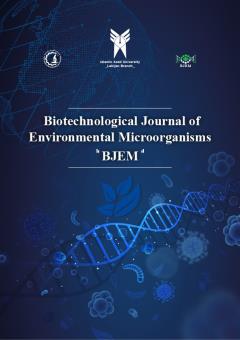Microbial Hydrocarbon Mineralization Mechanisms in Petroleum Microbiology: ecological role and environmental applications
Subject Areas : Biotechnological Journal of Environmental Microbiology
Amirhossein Khorramian
1
*
,
Mohadeseh Zabeti
2
,
Narges Rohshandel
3
,
Mohammad Erfan Bagheri
4
,
Arman Moardi
5
![]()
1 - Department of Microbiology, Ard.c., Islamic Azad University, Ardabil, Iran
2 - Department of Microbiology,La.C.,Islamic Azad University, Lahijan, Iran
3 - Department of Biotechnology,La.C.,Islamic Azad University, Lahijan, Iran
4 - Department of Microbiology,La.C.,Islamic Azad University, Lahijan, Iran
5 - Department of Microbiology,La.C.,Islamic Azad University, Lahijan, Iran
Keywords: Microbial mineralization, Bacillus mucilaginosus, Rhodococcus indonesiensis, Pseudomonas aeruginosa, Acinetobacter baumannii, Bioremediation, Petroleum microbiology,
Abstract :
Hydrocarbon microbes play a key role in the mineralization process of hydrocarbon compounds in petroleum environments. These processes are carried out through multiple biochemical and biological mechanisms and lead to the complete decomposition of hydrocarbons. In this context, types of microbes such as Bacillus mucilaginosus, Rhodococcus indonesiensis, Pseudomonas aeruginosa, and Acinetobacter baumannii have the ability to decompose petroleum compounds. These microbes convert complex petroleum compounds into simpler metabolites using methods such as aerobic and anaerobic oxidation, the activity of specific enzymes such as oxygenase and hydroxylase, and the production of biosurfactants, and ultimately cause the mineralization and safe removal of pollutants. From an ecological perspective, these microbes help maintain the biological balance of the environment and play an important role in the restoration of contaminated ecosystems by expanding microbial diversity and improving the physical and chemical properties of soil and water. Their environmental applications include bioremediation of oil-contaminated lands and water resources, reduction of biotoxicity, and restoration of damaged habitats. The study provides a new perspective on the challenges and opportunities in utilizing these microbes and emphasizes the importance of using microbial consortia in petroleum microbiology.
1) Sui, X., Wang, X., Li, Y., & Ji, H. (2021). Remediation of petroleum-contaminated soils with microbial and microbial combined methods: Advances, mechanisms, and challenges. Sustainability, 13(16), 9267.
2) Zhang, M., Chen, Q., & Gong, Z. (2024). Microbial remediation of petroleum-contaminated soil focused on the mechanism and microbial response: A review. Environmental Science and Pollution Research, 31(23), 33325-33346.
3) Mekonnen, B. A., Aragaw, T. A., & Genet, M. B. (2024). Bioremediation of petroleum hydrocarbon contaminated soil: a review on principles, degradation mechanisms, and advancements. Frontiers in Environmental Science, 12, 1354422.
4) Gouthami, K., Mallikarjunaswamy, A. M. M., Bhargava, R. N., Ferreira, L. F. R., Rahdar, A., Saratale, G. D., ... & Mulla, S. I. (2023). Microbial biodegradation and biotransformation of petroleum hydrocarbons: progress, prospects, and challenges. Genomics Approach to Bioremediation: Principles, Tools, and Emerging Technologies, 229-247.
5) Verasoundarapandian, G., Wong, C. Y., Shaharuddin, N. A., Gomez-Fuentes, C., Zulkharnain, A., & Ahmad, S. A. (2021). A review and bibliometric analysis on applications of microbial degradation of hydrocarbon contaminants in arctic marine environment at metagenomic and enzymatic levels. International journal of environmental research and public health, 18(4), 1671.
6) Baghaie, A. H., & Keshavarzi, M. (2025). Strategies to Enhance Bioremediation of Petroleum Hydrocarbon Degradation in Contaminated Environments: A Review. Journal of Human Environment and Health Promotion, 11(3), 138-150.
7) Li, Y., Yang, J., Song, Y., & Wei, M. (2025). Progress in biostimulation-based remediation of TPH-contaminated soils: a comprehen

